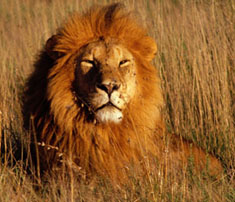|
New
research shows that lion manes do not help protect fighting lions
as was commonly thought.
by Virginia Hughes
 Photo courtesy
of Bruce Patterson
Photo courtesy
of Bruce Patterson
Male lions
often fight to the death for access to a pride - and whether they have
a sparce or shaggy mane may be irrelevant as a form of protection.
|
|
The purpose of the male lion's mane
has long perplexed biologists. Because female lions roam in groups
of three or four, and allow only one male to reside with them, competition
between males is fierce. Rival males often fight to the death-with
their enormous teeth and claws-to gain coveted access to a pride.
This led many biologists - including Charles Darwin - to assume
that the function of the thick manes was to make it harder for attackers
to reach the vulnerable throat area. But over the years this assumption
has been questioned by field biologists who actually saw lions fight
and noticed that the mane area was rarely targeted.
Evolutionary biologist Peyton West and her colleagues from the University of Minnesota used life-size lion dummies to test if manes indeed offered protection. The researchers first lured some lions to the testing area by playing tapes of hyenas feeding at a kill, then presented them with the fake rivals. "Of course we worried that the lions wouldn't be fooled," West says. But many of the real lions attacked the fakes with a vengeance. Sometimes the fakes worked so well in fact, that even after the real lions knocked them over, they tended to stick around and maul them some more.
The real lions didn't attack the models at the neck, but on the back and hindquarters, putting a serious snarl in the protective mane hypothesis. To see if the males were avoiding the neck because the mane was acting as a shield, the researchers repeated the tests with "maneless" fakes. But even with these exposed-neck models, the real lions went first for the backside. "We were pretty surprised to find so little evidence for protection," West says. "It's so intuitive that the mane would work that way."
But it turns out those shaggy manes
are used for attracting females. In previous research published
in 2002, West had shown that males with longer and darker manes
were older, better fed, and better fighters. And because females
rely on males to protect their cubs, it makes sense that females
would prefer males with large manes. "Just as songbirds can advertise
their quality though visual cues, so, apparently, do lions," says
field biologist Jon Grinnell of Gustavus Adolphus College in Minnesota.
Grinnell says that West's study is new and interesting because it
forces us to look at lions differently.
 Photo
courtesy of Peyton West
Photo
courtesy of Peyton West
Shaggy manes
help lions attract females.
|
Even though today manes don't seem
to offer protection, West says a protective role could have been
the reason the trait evolved in the first place. In the early evolution
of the trait, males may have gone straight for the neck, making
individuals with manes harder to attack and thus more favored by
natural selection. As evolution continued and more and more males
developed manes, attacking the neck area would no longer have been
an effective fighting strategy, causing lions to try for the back
side instead.
But the natural selection theory has recently been contested by a new study. Research led by Dr Bruce Patterson from The Field Museum shows that a lion's mane can vary in thickness depending on the local climate and is not a result of evolution. Although useful for attracting a mate, a thick mane also comes at a price: it takes energy to grow and maintain, is cumbersome, makes a lion more visible and therefore can attract prey, can harbor parasites and most importantly, retains heat. In a northern climate, it helps a lion keep warm but in hotter areas, the lion risks overheating and so differential hair growth keeps the mane thinner.
 Photo
courtesy of Bruce Patterson
Photo
courtesy of Bruce Patterson
Maybe he's
born with it? Maybe not, as new research shows that the
thickness of a lion's mane can change depending on the climate
where they live.
|
After studying 19 lions in zoos across
the United States covering a variety of climates, the researchers
found that there was a correlation between mane variation and temperature,
most significantly in cold weather where manes were seen to change
the most. These results may cause scientists to reevaluate the lion
family tree, since lions have largely been classified based on their
physical appearance and the length and thickness of their mane.
The adaptability of the lion mane gives
hope for lions' survival in the wild. A better understanding of
their physionomy and behaviour will also help conservationists reestablish
dwindling populations. "The lion is an intensively studied species
and probably the best known wild cat on earth," says field biologist
Luke Hunter of Wildlife Conservation Society-International, "but
good science is still revealing new things about the species and
turning over popular misconceptions."
For more info, visit:
American Scientist - The Lion's Mane
http://www.americanscientist.org/template/AssetDetail/assetid/42393
Newswise - Lion Manes Linked to Climate
http://www.newswise.com/articles/view/519488/?sc=swhn
|
